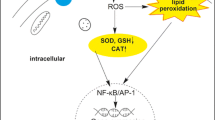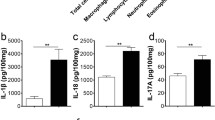Abstract
Alveolar macrophages secrete numerous mediators, playing an important role in host defence. Among these mediators, nitric oxide (NO) and hydrogen peroxide (H2O2) are both involved in bactericidal killing and trigger the release of other cellular metabolites. We have analyzed the effect of an atmosphere polluted with ozone (0.03–0.5 ppm v/v) on the monocytic cell line THP-1, as a model for alveolar macrophages,in vitro. NO and H2O2 were chosen to evaluate cell response to ozone. Cell injury was evaluated using lactate dehydrogenase (LDH) liberation into the medium. An exposure to 0.5 ppm ozone proved to be more toxic to the cells, than 0.1 or 0.03 ppm, evidenced by more LDH being liberated and cytotoxicity reaching values up to 64%. For all ozone concentrations, H2O2 production reached a peak value after 10–15 min of exposure, after which the concentration of extracellular H2O2 production diminished rapidly. The highest NO concentrations were measured with 0.5 ppm ozone, reaching a maximum value of 1460 nmol/L per 5×106 cells, which is 1.55 times higher than for nonexposed cells. Lower concentrations barely induced higher NO concentrations compared to nonexposed cells. The results indicate that ozone effects not only the viability of human monocytes but also the release of antibacterial and defense signaling molecules and suggest that ozone-mediated cytotoxicity may be related to the secretion of NO and H2O2.
Similar content being viewed by others
References
Åbrink M, Gobi AE, Huang R, Nilsson K, Hellman L. Human cell lines U-937, THP-I and Mono Mac 6 represent rela-tively immature cells of the monocyte-macrophage cell lineage. Leukemia. 1994;8(9): 1579-84.
Arsalane K, Gosset P, Vanhee D, et al. Ozone stimulates synthesis of inflammatory cytokines by alveolar macro-phages in vitro. Am J Respir Cell Mol Biol. 1995:13:60-8.
Avissar NE, Reed CK, Cox C, Frampton MW, Finkelstein JN. Ozone, but not nitrogen dioxide, exposure decreases glu-tathione peroxidases in epithelial lining fluid of human lung. Am J Respir Crit Care Med. 2000;162(4 Pt l):1342-7.
Bhalla DK. Ozone induced lung inflammation and mucosal barrier disruption: toxicology, mechanisms and implica-tions. J Toxicol Environ Health B. 1999:2:31-86.
Bhalla DK, Crocker TT. Tracheal permeability in rats exposed to 03. An electron microscopic an autoradiographic analy-sis of the transport pathway. Am Rev Respir Dis. 1986;134: 572-9.
Bhalla DK, Rasmussen RE, Daniels DS. Adhesion and motility ofpolymorphonuclear leukocytes isolated from the blood of rats exposed to ozone: potential biomarkers of toxicity. Toxicol Appi Pharmacol. 1993:123:177-86.
Chen F, Kuhn DC, Gaydos LJ, Demers LM. Induction of nitric oxide and nitric oxide synthase mRNA by silica and lipopolysaccharide in PMA-primed THP-I cells. APMIS. 1996:104:176-82.
Decker T, Lohmann-Matthes M-L. A quick and simple method for the quantitation of lactate dehydrogenase release in measurements of cellular cytotoxicity and tumor necrosis factor (TNF) activity. J Immunol Methods. 1988:15:61-9.
Deviin RB, McDonnell WF, Mann R, et al. Exposure of humans to ambient levels of ozone for 6.6 hours causes cellular and biochemical changes in the lung. Am J Respir Cell Mol Biol. 1991:4:72-81.
Fridovich I. The biology of oxygen radicals. Science. 1978:201: 875-9.
Friedman M, Madden MC, Samet JM, Koren HS. Effects of ozone exposure on lipid metabolism in human alveolar macrophages. Environ. Health Perspect. 1992:97:95-101.
Gilmour MI, Hmieleski RR, Stafford EA, Jakab GJ. Suppres-sion and recovery of the alveolar phagocytic system during continuous exposure to 0.5 ppm ozone, Exp. Lung Res. 1991;17(3):547-58.
Glaze WH. Reaction products of ozone: a review. Environ Health Perspect. 1986:69:151-7.
Guevara I, Iwanejko J, Dembinska-Kiec A, et al. Determina-tion of nitrite/nitrate in human biological material by the simple Griess reaction. Clin Chim Acta. 1998;274:177-88.
Halliwell B. Free radicals, proteins and DNA: oxidative da-mage versus redox regulation. Biochem Soc Trans. 1996;24(4): 1023-27.
Holtzman MJ, Fabbri LM, O'Byrne PM, et al. Importance of airway inflammation for hyperresponsiveness induced by ozone. Am Rev Respir Dis. 1983;127(6):686-90.
Huffman LJ, Judy DJ, Castranova V. Regulation of nitric oxide production by rat alveolar macrophages in response to silica exposure. J Toxicol Environ Health. 1998;53(PartA):29-46.
Hunt C, Sim JE, Sullivan SJ, et al. Genomic instability and catalase gene amplification induced by chronic exposure to oxidative stress. Cancer Res. 1998:58:3986-92.
Jesch NK, Dörger M, Enders G, et al. Expression of inducible nitric oxide synthase and formation of nitric oxide by alveolar macrophages: an interspecies comparison. Environ Health Perspect. 1997;105(5):1297-300.
Kanofsky JR, Sima P. Singlet oxygen production from the reactions of ozone with biological molecules. J Biol Chem. 1991;266(14):9039-42.
Kelley WN. Textbook of internal medicine, 2nd edn. London: J.B. Lippincott; 1992.
Kimura A, Goldstein E. Effect of ozone on concentrations of lysozyme in phagocytizing alveolar macrophages. J Infect. Dis. 1981:143:247-51.
Knowles RG. Nitric oxide biochemistry. Biochem Soc Trans. 1997;25(3):895-901.
Koren HS, Deviin RB, Graham DE, et al. Ozone-induced inflammation in the lower airways of human subjects. Am Rev Respir Dis. 1989;139(2):407-15.
Korzeniewski C, Callewaert D. An enzyme-release assay for natural cytotoxicity. J Immunol Methods. 1983:64:313-20.
Laval-Gilly P. Analyse de la mobilite des macrophages pour ie developpment d'un biocapteur atmospherique. Doctoral Thesis, University of Metz, France; 2000.
Laval-Gilly P, Falla J, Klestadt D, Henryon M. A new approach to evaluate toxicity of gases on mobile cells in culture. J Pharmacol Toxicol Methods. 2000;44(3):483-8.
MacMicking J, Xie Q, Nathan C. Nitric oxide and macrophage function. Annu Rev Immunol. 1997:15:323-50.
Mayer D, Ebert W. Damage of human lung fibroblasts by ozone. Fifth Annual Report of the European Research Centre for Air Pollution Control Measures. 1989; KfK-PEF 50, vol. 2: 423-31.
Menzel DB. Ozone: an overview of its toxicity in man and animals. J Toxicol Environ Health. 1984;13(2-3):183-204.
Miles PR, Bowman L, Rengesamy A, Huffman L. Constitutive nitric oxide production by rat alveolar macrophages. Am J Physiol Lung Cell Mol Physiol. 1998;18(3):L360-8.
Mochitate K, Ishida K, Ohsumi T. Long-term effects of ozone and nitrogen dioxide on the metabolism and population of alveolar macrophages. J Toxicol Environ Health. 1992;35: 247-60.
Mohanty JG, Jaffe JS, Schulman ES, Raible DG. A highly sensitive fluorescent micro-assay of H2O2 release from activated human leukocytes using a dihydroxyphenoxazine derivative. J Immunol. 1997;202:133-41.
Mustafa MG. Biochemical basis of ozone toxicity. Free Radic Biol Med. 1990:9:245-65.
Costing RS, Van Golde LMG, Verhoef J, Van Bree L. Species differences in impairment and recovery of alveolar macro-phage functions following single and repeated ozone expo-sures. ToxicolAppI Pharmacol. 1991;110(l):170-8.
Parker RF, Davis JK, Cassell GH, et al. Short-term exposure to nitrogen dioxide enhances susceptibility to murine respira-tory mycoplasmosis and decreases intrapulmonary killing of Mycoplasma pullmonis. Am Rev Respir Dis. 1989;140: 502-12.
Pearson AC, Bhalla DK. Effects of ozone on macrophage adhesion in vitro and epithelial and inflammatory responses in vivo: the role of cytokines. J Toxicol Environ Health. 1997:50:143-57.
Perez-Arellano BN, Alcazar-Montero MC, Jimenez-Lopez A. Alveolar macrophage: origin, kinetics and relationship with cells of the alveolo-interstitial region. Allergol Immuno-pathol. 1990; 18(3): 175-83.
Pick E, Keisari Y. A simple colorimetric method for the measurement of hydrogen peroxide produced by cells in culture. J Immunol Methods. 1980:38:161-70.
Pryor WA, Squadrito GL, Friedmann M. A new mechanism for the toxicity of ozone. Toxicol Lett. 1995:82/83:287-93.
Schmidt HHHW. Determination of nitric oxide via measure-ment of nitrite and nitrate in culture medium. Biochemica. 1995;2:22.
Stamler JS, Singel DJ, Loscaizo J. Biochemistry of nitric oxide and its redox-activated forms. Science. 1992:258(5090):1898-902.
Steinberg JJ, Gleeson JL, Gil D. The pathobiology of ozone-induced damage. Arch Environ Health. 1990;45(2):245-65.
Tsuchiya S, Yamabe M, Yamaguchi Y, Kobayashi Y, Konno T, Tada K. Establishment and characterization of a human acute monocytic leukemia cell line (THP-I). Int J Cancer. 1980:26:171-6.
Valentine R. An in vitro system for exposure of lung cells to gases: effects of ozone on rat macrophages. J Toxicol Environ Health. 1985:16:115-26.
Voisin C, Aerts C, Jakubczak E, Tonnel AB. La culture cellulaire en phase gazeuse. Un nouveau modele experi-mental d'etude 171 vitro des activites des macrophages alveolaires. Bull Eur Physiopathol Resp. 1977:13:69-82.
Voisin C, Aerts C, Tonnel AB, Dutriez N. Action des polluants gazeux de l'atmosphere (NO2, 03) sur la défense phagocy-taire de l'appareil respiratoire: évaluation in vitro. Bull Int Tubercul. 1979:54:416-9.
Wallaert B, Gosset P, Boitelle A, Tonnel AB. In vitro assessment of environmental toxicology using alveolar cells as target. Cell Biol Toxicol. 1996:12:251-6.
Whiteside C, Hassan HM. Role ofoxyradicals in the inactiva-tion ofcatalase by ozone. Free Radic Biol Med. 1988:5(5-6):305-12.
Author information
Authors and Affiliations
Rights and permissions
About this article
Cite this article
Klestadt, D., Laval-Gilly, P. & Falla, J. Ozone-mediated cytotoxicity after short-term exposure and its relation to the production of cellular metabolites (NO, H2O2). Cell Biol Toxicol 18, 259–269 (2002). https://doi.org/10.1023/A:1016055011920
Issue Date:
DOI: https://doi.org/10.1023/A:1016055011920




